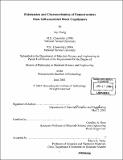Fabrication and characterization of nanostructures from self-assembled block copolymers
Author(s)
Cheng, Joy, 1974-
DownloadFull printable version (21.30Mb)
Other Contributors
Massachusetts Institute of Technology. Dept. of Materials Science and Engineering.
Advisor
Caroline A. Ross.
Terms of use
Metadata
Show full item recordAbstract
Nanoscale magnetic dot arrays have attracted considerable interest, both for fundamental studies of micromagnetism and for possible applications in high-density magnetic data storage. Self-assembled block copolymers provide an alternative nanolithography technique to fabricate large-area nanomagnet arrays. Block copolymer thin films that micro-phase separate into periodic domains can be used as templates to define arrays of close-packed nanostructure, using a series of etching steps. Using polystyrene-polyferrocenyldimethyl-silane (PS-PFS), large-area polymer dots, silica dots and magnetic dots with periods of 56 nm were made using a series of plasma etching steps. Magnetometry techniques are used to characterize the bulk magnetic behavior of the dot arrays of Co, NiFe and pseudo spin valve structures. These dot arrays show strong magnetostatic interaction between the dots and within the dots. The self-assembly process is simple and low cost, however, the block copolymers typically have uncontrolled defects and lack long-range order. A topographically patterned substrate is used to guide the phase-separation in a subsequently deposited block copolymer film. The lateral dimensions of the patterns in the substrates, and interfacial interactions, are key factors in the ordering mechanism. Well-ordered block copolymer structures can be achieved under proper confinement conditions. In addition, the position of the polymer microdomains and defects in the array such as dislocations can be purposefully controlled by the design of the topographical guiding features. Combining topographic confinement with block copolymer lithographic methods will enable large-area ordered functional dot arrays to be made for various applications.
Description
Thesis (Ph. D.)--Massachusetts Institute of Technology, Dept. of Materials Science and Engineering, 2003. Includes bibliographical references (leaf 109).
Date issued
2003Department
Massachusetts Institute of Technology. Department of Materials Science and EngineeringPublisher
Massachusetts Institute of Technology
Keywords
Materials Science and Engineering.